Chapter: 11th Physics : UNIT 2 : Kinematics
Concept of Rest and Motion
CONCEPT OF REST AND
MOTION
The
concept of rest and motion can be well understood by the following elucidation
(Figure 2.1). A person sitting in a moving bus is at rest with respect to a
fellow passenger but is in motion with respect to a person outside the bus. The
concepts of rest and motion have meaning only with respect to some reference
frame. To understand rest or motion we need a convenient fixed reference frame.

Frame of Reference:
If
we imagine a coordinate system and the position of an object is described
relative to it, then such a coordinate system is called frame of reference.
At
any given instant of time, the frame of reference with respect to which the
position of the object is described in terms of position coordinates (x, y, z)
(i.e., distances of the given position of an object along the x, y, and z-axes.)
is called “Cartesian coordinate system” as
shown in Figure 2.2
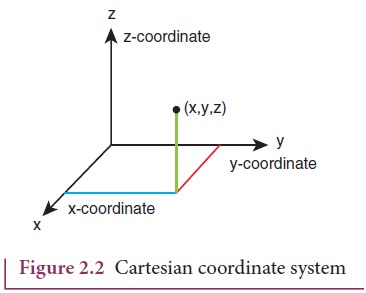
It
is to be noted that if the x, y and z axes are drawn in anticlockwise
direction then the coordinate system is called as “right- handed Cartesian
coordinate system”. Though other coordinate systems do exist, in physics we
conventionally follow the right-handed coordinate system as shown in Figure
2.3.
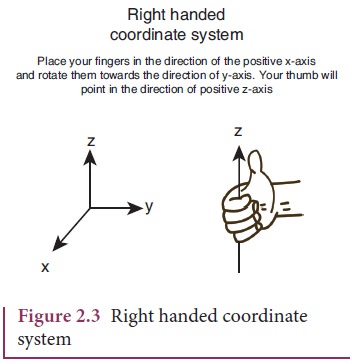
The
following Figure 2.4 illustrates the difference between left and right handed
coordinate systems.
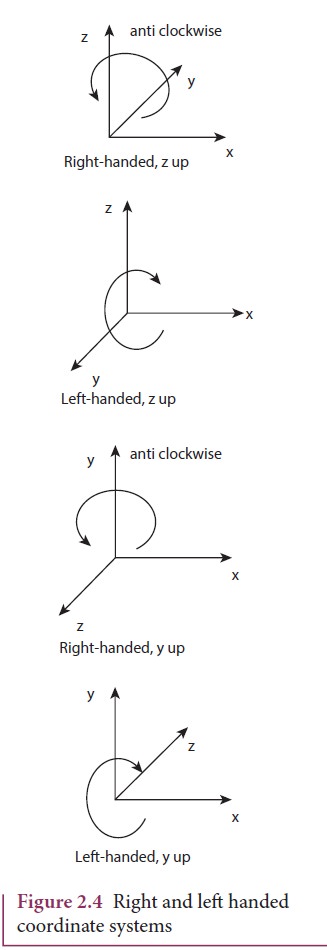
Point mass
To
explain the motion of an object which has finite mass, the concept of “point
mass” is required and is very useful. Let the mass of any object be assumed to
be concentrated at a point. Then this idealized mass is called “point mass”. It
has no internal structure like shape and size. Mathematically a point mass has
finite mass with zero dimension. Even though in reality a point mass does not
exist, it often simplifies our calculations. It is to be noted that the term
“point mass” is a relative term. It has meaning only with respect to a
reference frame and with respect to the kind of motion that we analyse.
Examples
·
To
analyse the motion of Earth with respect to Sun, Earth can be treated as a
point mass. This is because the distance between the Sun and Earth is very
large compared to the size of the Earth.
·
If
we throw an irregular object like a small stone in the air, to analyse its
motion it is simpler to consider the stone as a point mass as it moves in
space. The size of the stone is very much smaller than the distance through
which it travels.
Types of motion
In
our day‒to‒day life the following kinds of motion are observed:
a. Linear motion
An
object is said to be in linear motion if it moves in a straight line.
Examples
·
An
athlete running on a straight track
·
A
particle falling vertically downwards to the Earth.
b. Circular motion
Circular
motion is defined as a motion described by an object traversing a circular
path.
Examples
·
The
whirling motion of a stone attached to a string
·
The
motion of a satellite around the Earth
These
two circular motions are shown in Figure 2.5
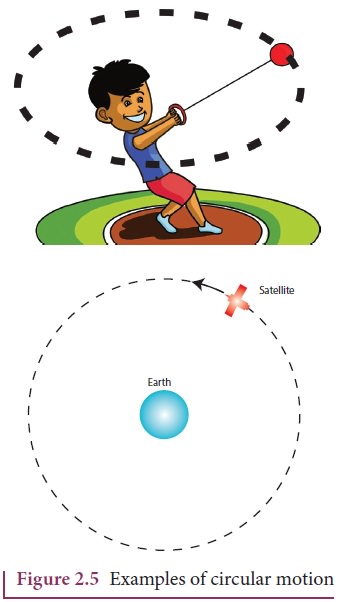
c. Rotational motion
If
any object moves in a rotational motion about an axis, the motion is called
‘rotation’. During rotation every point in the object transverses a circular
path about an axis, (except the points located on the axis).
Examples
·
Rotation
of a disc about an axis through its center
·
Spinning
of the Earth about its own axis.
These
two rotational motions are shown in Figure 2.6.
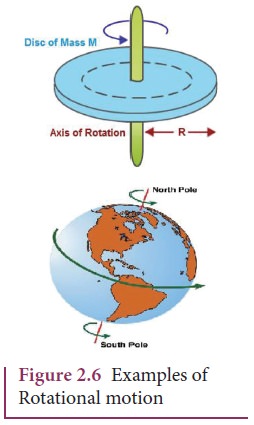
d. Vibratory motion
If
an object or particle executes a to-and-
fro motion about a fixed point, it is
said to be in vibratory motion. This
is sometimes also called oscillatory motion.
Examples
·
Vibration
of a string on a guitar
·
Movement
of a swing
These
motions are shown in Figure 2.7

Other
types of motion like elliptical motion and helical motion are also possible
Motion in One, Two and Three Dimensions
Let
the position of a particle in space be expressed in terms of rectangular
coordinates x, y and z. When these coordinates change with time, then the
particle is said to be in motion. However, it is not necessary that all the
three coordinates should together change with time. Even if one or two coordinates
changes with time, the particle is said to be in motion. Then we have the
following classification.
i. Motion in one dimension
One dimensional motion is the motion
of a particle moving along a straight line.
This
motion is sometimes known as rectilinear or linear motion.
In
this motion, only one of the three rectangular coordinates specifying the
position of the object changes with time.
For
example, if a car moves from position A to position B along x-direction, as shown in Figure 2.8,
then the variation in x-coordinate alone is noticed.
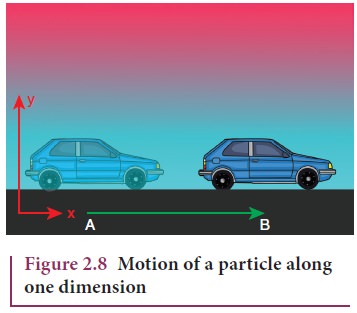
Examples
·
Motion
of a train along a straight railway track.
·
An
object falling freely under gravity close to Earth.
ii. Motion in two dimensions
If a particle is moving along a
curved path in a plane, then it is said to be in two dimensional motion.
In
this motion, two of the three rectangular coordinates specifying the position
of object change with time.
For
instance, when a particle is moving in the y
- z plane, x does not vary, but y
and z vary as shown in Figure 2.9
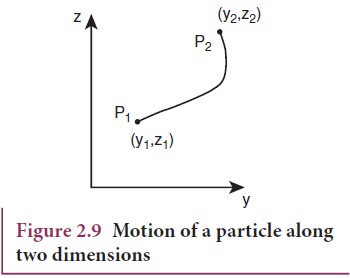
Examples
·
Motion
of a coin on a carrom board.
·
An
insect crawling over the floor of a room.
iii. Motion in three dimensions
A particle moving in usual three
dimensional space has three dimensional motion.
In
this motion, all the three coordinates specifying the position of an object
change with respect to time. When a particle moves in three dimensions, all the
three coordinates x, y and z will vary.
Examples
·
A
bird flying in the sky.
·
Random
motion of a gas molecule.
·
Flying
of a kite on a windy day.
Related Topics